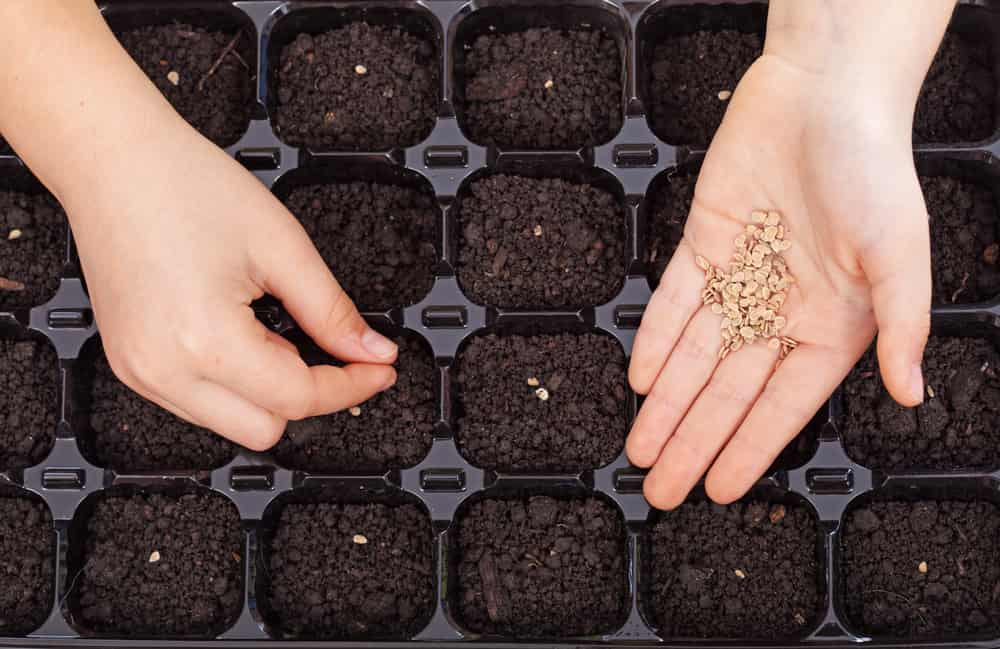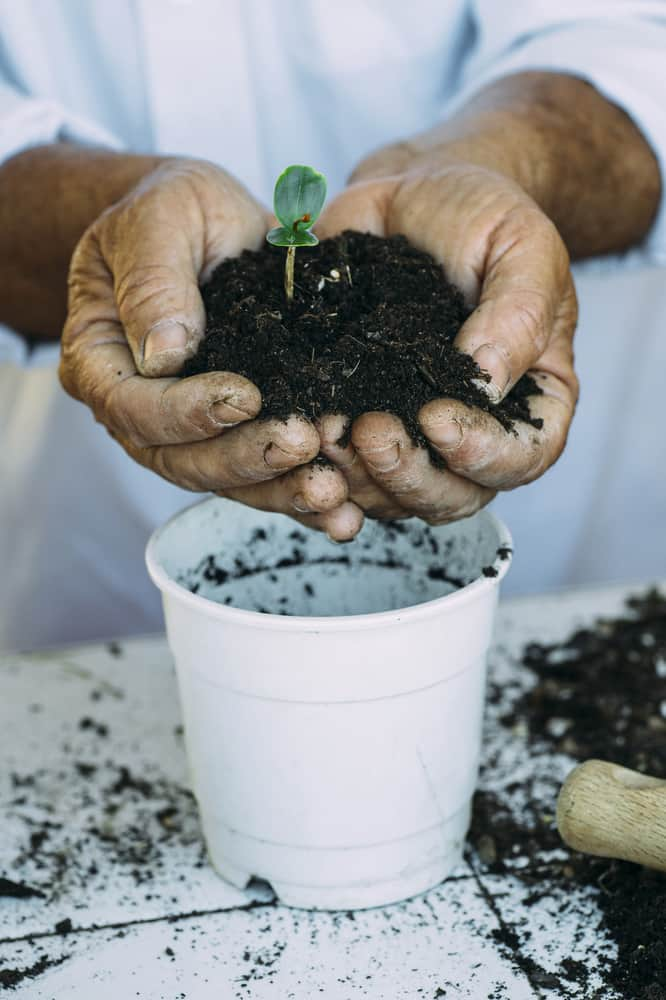Pothos are not heavy bloomers, and when there is a lack of blooms, there is a lack of seeds. Because of this, pothos are most often propagated from cuttings.
That doesn’t mean, however, that you cannot use pothos seeds as a way to get more of these beautiful plants in your home.
Keep reading to find out how!

Table of Contents
Can I grow pothos from seeds?
Yes. There is more than one way to grow pothos, and by seed is one such method. Pothos can successfully grow from seeds, though it is much harder than with the other method of propagating pothos. For pothos, the most common method of propagating is via cutting.
The process of growing pothos from seeds is done in the same manner as growing other plants from seeds. It will require germinating the seed and then, when it gets big enough, transplanting it to a different pot.
Keep in mind, however, that growing pothos from seeds will take much longer than growing the plant from a cutting. Furthermore, unlike a cutting, you cannot be sure what variegation you will get from pothos seeds. Because of the extra time it takes to grow pothos seeds, most people choose to obtain a pothos plant that is already established or purchase a cutting to grow, especially if you’re hoping to have a pothos that’s variegated.
How long does it take to grow pothos from seeds?
The exact timeframe that it takes to grow pothos from seeds varies due to several factors. The germination process alone can take a week or more and then an additional 2 to 3 weeks before the sprouted seeds turn into seedlings.
It can then take several more weeks before you can transplant the young pothos from its starter pot to a more permanent container. Once it has grown large enough to repot, your pothos will tend to grow faster. During its active growing season, an adult pothos can grow 10 to 18 inches a month.
The amount of time it takes to grow pothos from seed is one of the main reasons why gardeners choose to forgo this propagating method. You can cut this time down in half by simply obtaining a cutting of the pothos instead.

How can I speed up my pothos seeds growing?
The best way to speed up your pothos seeds’ growth is to provide the plant with its ideal growing conditions. You want to mimic the plant’s natural environment as much as possible. This will encourage the plant to grow quicker and healthier.
Keep in mind, however, that there is not much else you can do to increase its growth rate. A plant will only grow as fast as it is designed to.
Giving the plant its optimal growing conditions helps to encourage growth, but it won’t make a plant that is naturally slow growing grow as fast as a naturally fast grower.
How to grow pothos from seeds?
Growing pothos seeds isn’t a difficult process, but it does take time and patience. In fact, growing pothos seeds is similar to growing just about any other seed. The real challenge is obtaining pothos seeds to begin with.
1. Prepare the seeds
Fill a bowl with water and dump about 1 tablespoon of pothos seeds into it. Use your finger or a stir stick to stir the seeds for several seconds and then let them settle to the bottom.
Discard any pothos seeds that are floating on the top since they won’t germinate.
2. Leave the seeds
Leave the seeds that are at the bottom of the bowl in the water to soak for about 12 hours. Avoid letting them soak for longer than that, since it can increase the chance of them rotting.
3. Prepare the starter pot
Use a starter pot that has drainage holes along the bottom and fill with potting soil that contains sand, garden soil, perlite, and cocopeat. Place the pot on a tray.
This step is particularly important if you have multiple starter pots.

4. Plant the seeds
Make small depressions in the soil, making sure they are not too deep. Drop one or two pothos seeds into the dent you made in the soil and then lightly cover them with soil.
Water until the soil and starter pot is damp but not dripping wet.
5. Cover the seeds
Place a single layer of plastic wrap over the seeds to create a sort of makeshift greenhouse. Once the seeds are covered, set the tray away from direct light and direct heat.
A dark area with good airflow where the seeds won’t be bothered is ideal.
6. Keep the seeds and soil moist
The soil will need to stay moist during the germination process, but you don’t want to make the soil soggy. Use a spray bottle to mist the soil with water to keep the seeds from drying out.
Furthermore, consider using filtered or distilled water during this process since it will reduce the chance of the seeds developing a fungal or bacterial infection.

7. Increase airflow to the seedlings
After 2 to 3 weeks, the seeds will have started sprouting. At this time, either remove the plastic wrap or poke holes in it to allow for good airflow. Move the plants to a shady area where they can receive moderate humidity and temperature.
8. Increase the amount of watering
The bigger the seedlings get, the more water they will need. Keep the soil of the pothos seedlings moist but not soggy. Check the soil every few days to ensure it doesn’t dry out.
9. Repot the seedlings
When the seedlings have developed two or three leaves, it’s time to repot them.
Choose a pot that is about 3 times the size of the seedling’s root ball, and make sure it has drainage holes at the bottom, as pothos plants need drainage to thrive.

10. Provide proper care
Give the young pothos the same type of care as you would an adult plant. Keep it in an area where it will receive bright, indirect sunlight, and temperatures between 70 and 90 degrees Fahrenheit.
In terms of how often to water your pothos, it’s best to do so whenever the top one or two inches of soil starts to feel dry, and feed the plant once a month during its active growing period.
11. Be vigilant
While pothos are not overly prone to any disease or pest, they can experience problems like any other houseplant. Sap-sucking insects, such as spider mites and mealybugs, can occur but are not usually too big of a problem. If you notice any of these insects of the pothos, simply treat the plant with insecticidal soap.
As for diseases, the most common issue with pothos is root rot, which occurs when the plant is overwatered or is growing in poor soil. Thankfully, these issues are typically easy to prevent as long as you avoid watering the plant too much and ensure it is growing in well-drained soil.
How to get pothos seeds
Getting your hands on pothos seeds can be rather difficult, since these seeds are considered rare. If you know someone who is familiar with rare seeds, they may be able to provide you with some or point you in the right direction of where you can purchase them. If not, your next best option is to look online.
There are several online merchants that offer pothos seeds for sale. However, it is difficult to know exactly what variegation you will end up with when growing pothos from seeds. Furthermore, there are typically no guarantees that the seeds will germinate.
Instead of trying to locate the rare pothos seeds, consider growing the plant from a cutting instead. Cuttings are much easier to find, and even easier to grow. You may even have a friend or family member currently growing a pothos who would be more than happy to give you a cutting.
Should I buy pothos seeds?
More than likely, you will have to purchase pothos seeds since these are not something that gardeners have lying around. If you don’t want to order them online, reach out to your local nursery or garden center to discuss if they could possibly order pothos seeds for you.
No matter where you get your seeds from, however, a good portion of them may not even germinate. This is because most seeds don’t have a 100% germination rate, which means you are technically paying for seeds that won’t sprout.
Growing a pothos from a cutting, however, provides a higher rate of success. You also are more likely to obtain a cutting than seeds, and it is much easier and quicker to grow a pothos from a cutting. Keep that information in mind when deciding whether or not you should grow pothos seeds.

What do pothos seeds look like?
Pothos seeds look similar to other small seeds, measuring less than 1/2 of an inch with a brown or tan coloring. In the wild, the pothos will flower and produce these seeds. When grown as a houseplant, however, the chances of the pothos flowering and producing seeds is rather rare.
Because pothos seeds are so rare, most indoor gardeners will never see a pothos seed. Even in the wild, the pothos don’t flower as often as other plants, and seeds are not commonly seen.
Furthermore, because they look so similar to other tropical seeds, it would be hard to tell if you actually have real pothos seeds if you purchase them online.
Is it better to grow pothos from seeds or from a cutting?
For most people, it is better to grow pothos from a cutting. This will provide you with quicker results, and you are more likely to get the variegation that matches the plant the cutting was taken from. Furthermore, most people have more success growing pothos from cutting than from seeds.
That doesn’t mean that you shouldn’t grow pothos seeds. In fact, growing pothos from seeds can be a rewarding and fun experience, especially for those gardeners who desire to grow their plants from the ground up.
If you have never grown a pothos before, however, you should consider starting with a plant that is already a couple of years old, or with a pothos cutting.
Growing pothos from seeds doesn’t provide any benefit over growing the plant from cutting. Most gardeners who want to grow them from seed are doing so for personal reasons, just to see if they can.
This means that, in most cases, you are better off obtaining a pothos cutting and growing the plant in that manner.
